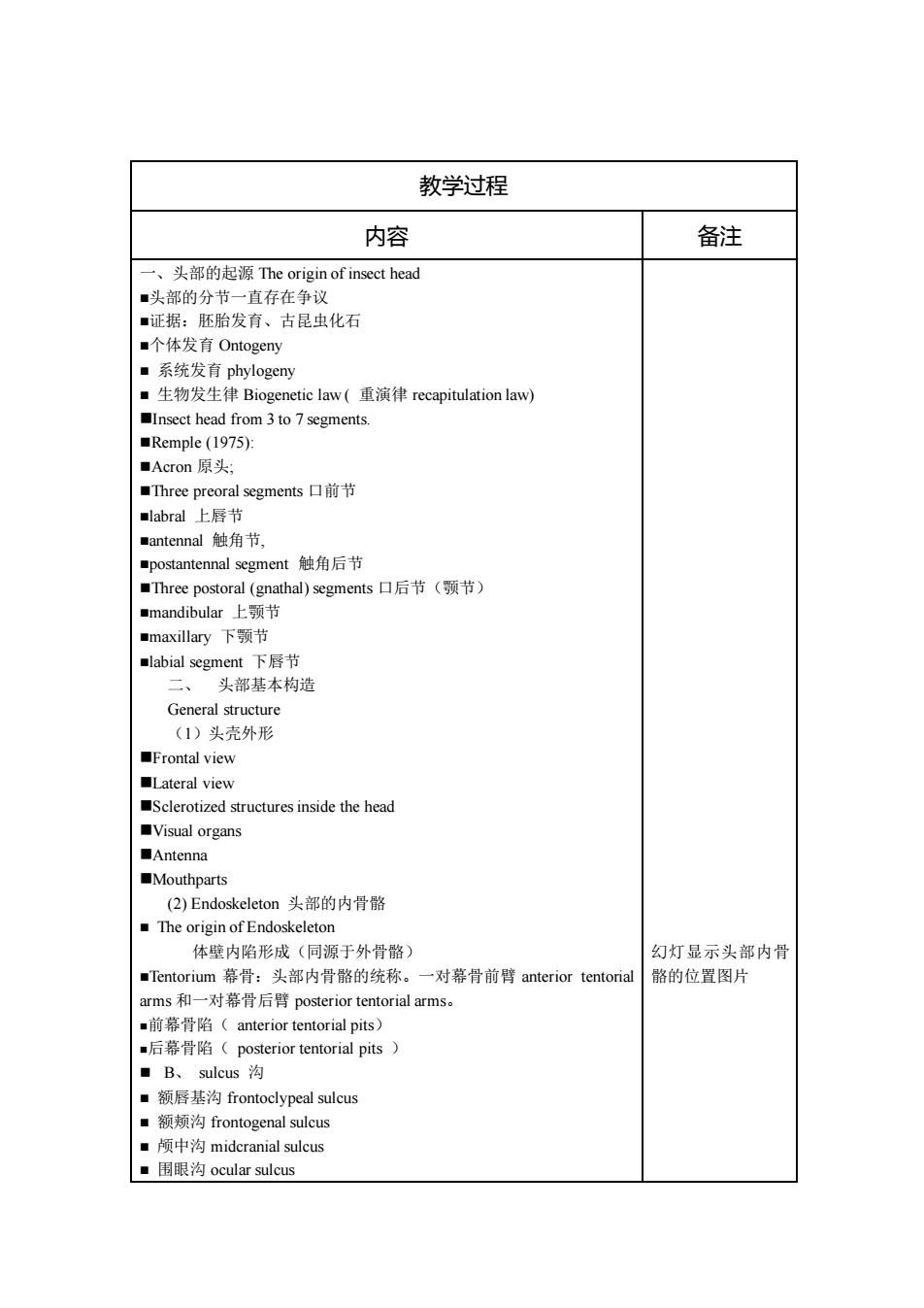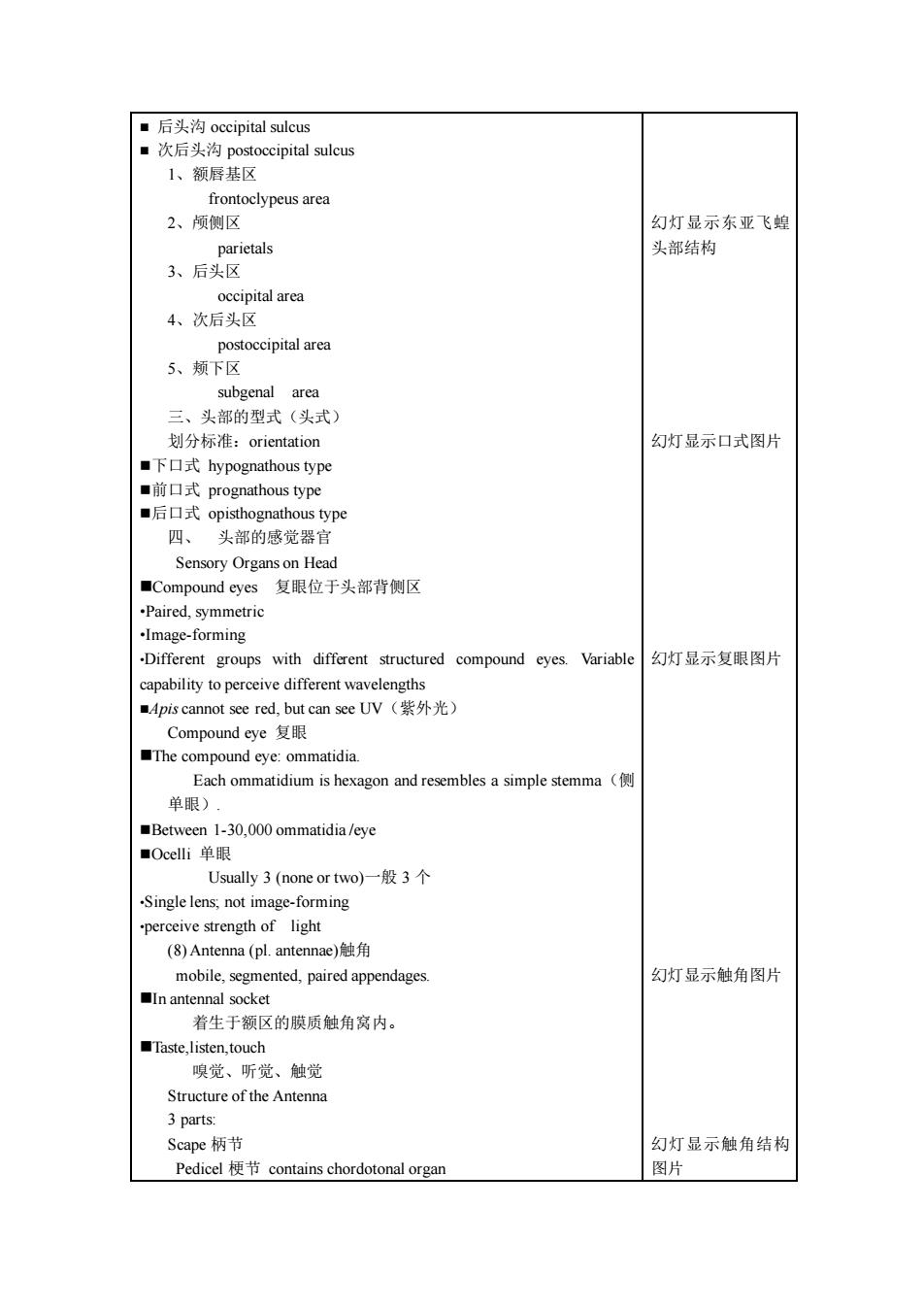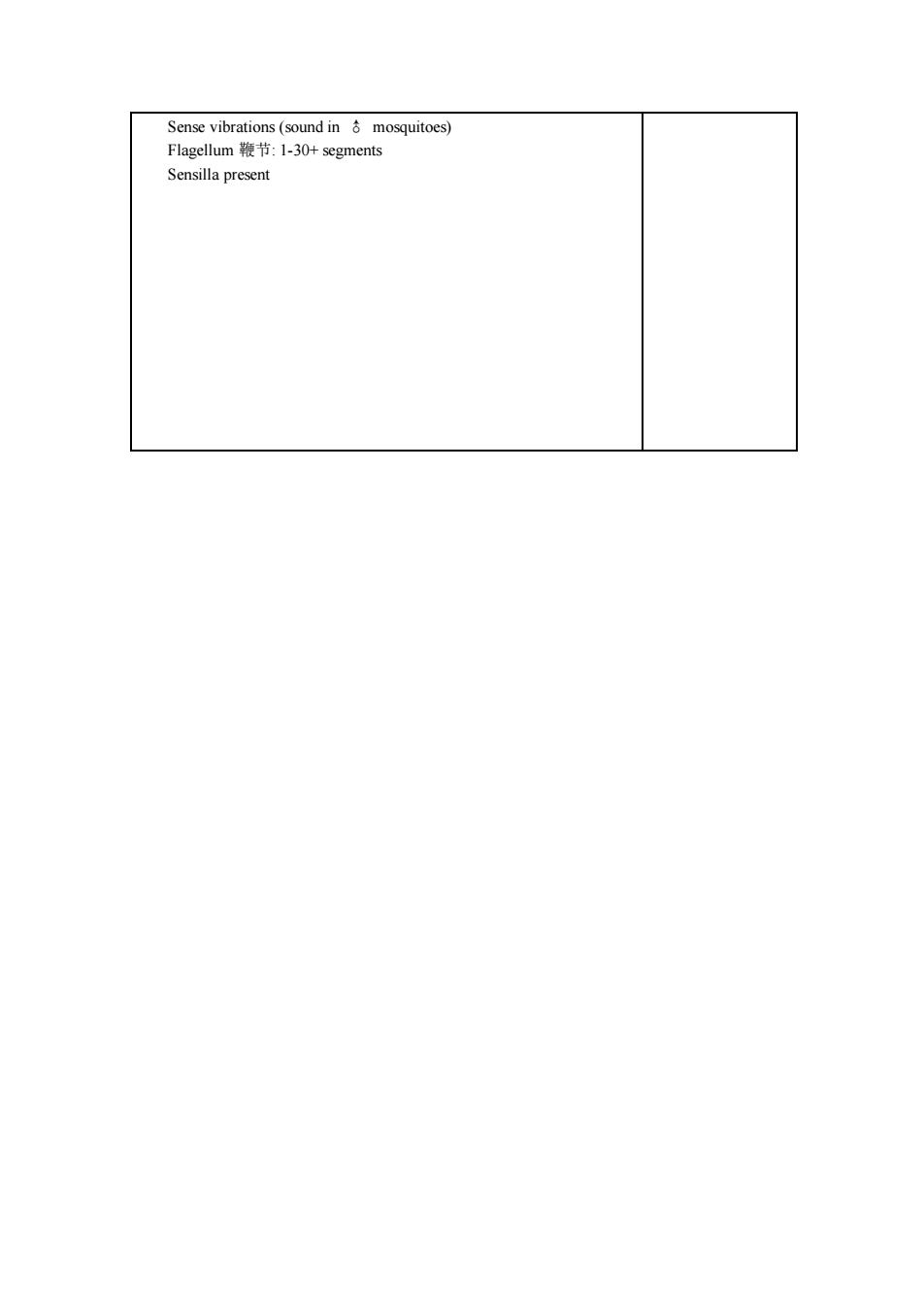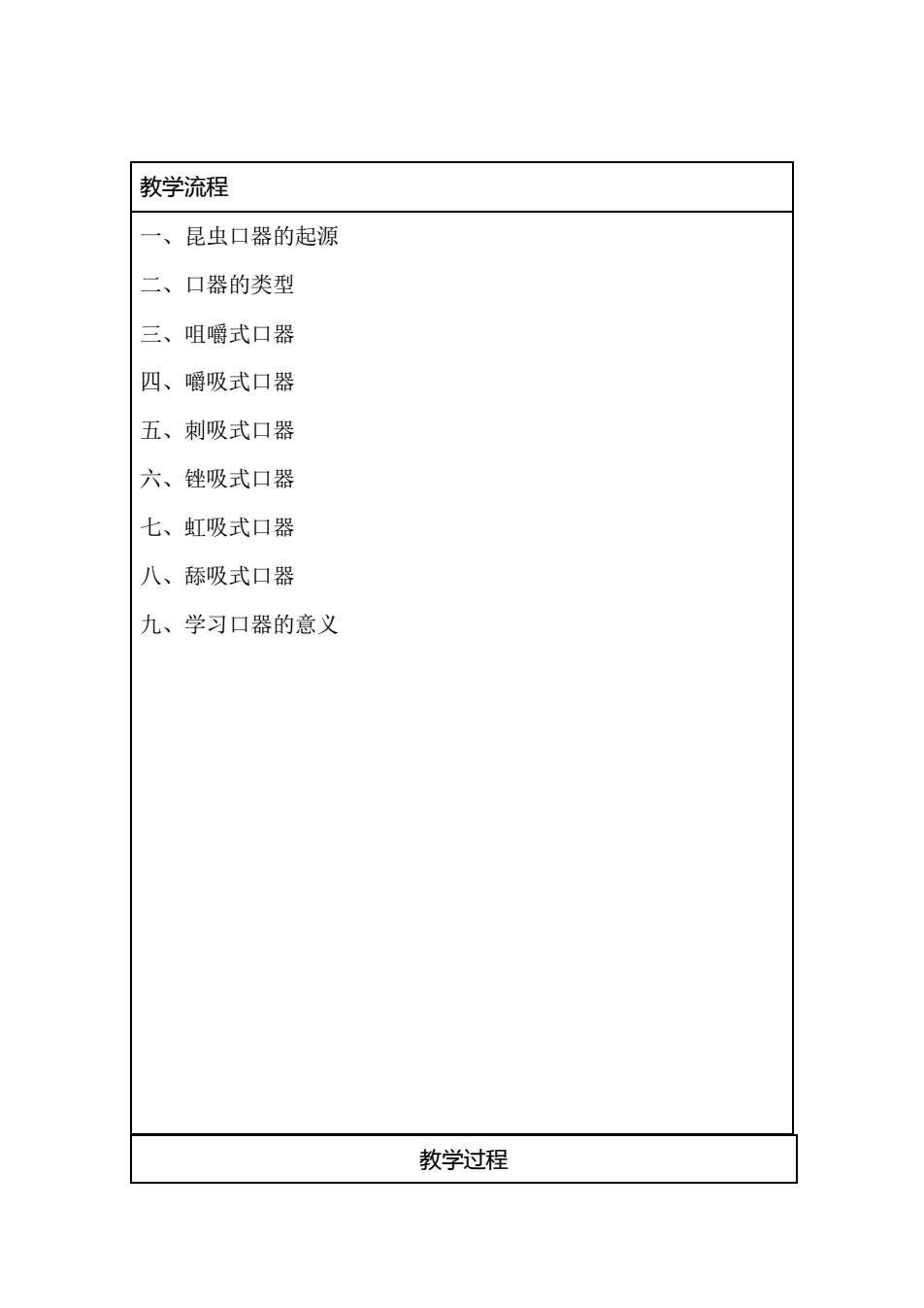
教学过程 内容 备注 孔.部的起源Th origin of insect head ■头部的分节 直存在争议 ■证据:胚胎发有、古昆虫化石 ■个体发育Ontogeny ·系统发有phylogen 生物发生律Biogenetic law(重演律recapitulation aw) nsect head. ■Remple(197S) ■Acron原头: ■Three preoral segments口前节 alabral上唇节 antennal触角节。 postantennal segment触角后节 ■Three postoral(gnathal)segments口后节(颚节) mmandibular上颚节 ■maxillary下秉节 General structure (1)头壳外形 ■Frontal view Lateral view ■Antenna ■Mouthparts (2)Endoskeleton头部的内骨骼 体雎内陷形成(同源于外骨骼 幻灯显示头部内骨 ■Tentorium幕骨:头部内骨骼的统称。一对幕骨前臂anterior tentorial骼的位置图片 ams和一对幕骨后臂posterior tentorial arms。. ,前幕骨陷(anterior tentorial pits) 后幕骨陷(pits) ·B、sulcus沟 ■额唇基沟frontocl小vpeal sulcus ·额颏沟frontogenal sulcus ■颅中沟midcranial sulcus ·围眼沟ocular sulcus
教学过程 内容 备注 一、头部的起源 The origin of insect head ◼头部的分节一直存在争议 ◼证据:胚胎发育、古昆虫化石 ◼个体发育 Ontogeny ◼ 系统发育 phylogeny ◼ 生物发生律 Biogenetic law ( 重演律 recapitulation law) ◼Insect head from 3 to 7 segments. ◼Remple (1975): ◼Acron 原头; ◼Three preoral segments 口前节 ◼labral 上唇节 ◼antennal 触角节, ◼postantennal segment 触角后节 ◼Three postoral (gnathal) segments 口后节(颚节) ◼mandibular 上颚节 ◼maxillary 下颚节 ◼labial segment 下唇节 二、 头部基本构造 General structure (1)头壳外形 ◼Frontal view ◼Lateral view ◼Sclerotized structures inside the head ◼Visual organs ◼Antenna ◼Mouthparts (2) Endoskeleton 头部的内骨骼 ◼ The origin of Endoskeleton 体壁内陷形成(同源于外骨骼) ◼Tentorium 幕骨:头部内骨骼的统称。一对幕骨前臂 anterior tentorial arms 和一对幕骨后臂 posterior tentorial arms。 ◼前幕骨陷( anterior tentorial pits) ◼后幕骨陷( posterior tentorial pits ) ◼ B、 sulcus 沟 ◼ 额唇基沟 frontoclypeal sulcus ◼ 额颊沟 frontogenal sulcus ◼ 颅中沟 midcranial sulcus ◼ 围眼沟 ocular sulcus 幻灯显示头部内骨 骼的位置图片

■后头沟occipital sulcus 。次后沟 1、额唇基区 frontoclypeus area 2、颅侧区 幻打显示东亚飞妈 头部结构 4、次后头区 postoccipital area 5、颊下区 subgenal area 三、头部的型式(头式) 划分标准:orientation 幻灯显示口式图片 ■下口式hypognathous type ■前口式prognathous type ■后口式opisthognathou 四、 Sensory Organs on Heac ■Compound eyes复眼位于头部背侧区 .Paired,symmetric .Image-forming -Different groups with different structured compound eyes..Variable幻灯显示复眼图片 capability to perceive different wavelengths ■4 pis cannot see red,.but can see UV(紫外光) Compound eve复眼 The compound eye:ommatidia. Each ommatidium is hexagon and resembles a simple stemma(侧 单眼》 Between 1-30,000 ommatidia/eye ■Ocei单眼 Usually3(none or two)一般3个 Single lens,not image-forming perceive strength of light (8)Antenna(pl.antennac)触角 mobile,segmented,paired appendages 幻灯显示触角图片 ■In antennal socket 着生于额区的膜质触角窝内。 ■Taste listen touch 嗅觉、听觉、触觉 Structure of the Antenna 3 parts: Scape柄节 幻灯显示触角结构 Pedicel梗节contains chordotonal organ 图片
◼ 后头沟 occipital sulcus ◼ 次后头沟 postoccipital sulcus 1、额唇基区 frontoclypeus area 2、颅侧区 parietals 3、后头区 occipital area 4、次后头区 postoccipital area 5、颊下区 subgenal area 三、头部的型式(头式) 划分标准:orientation ◼下口式 hypognathous type ◼前口式 prognathous type ◼后口式 opisthognathous type 四、 头部的感觉器官 Sensory Organs on Head ◼Compound eyes 复眼位于头部背侧区 •Paired, symmetric •Image-forming •Different groups with different structured compound eyes. Variable capability to perceive different wavelengths ◼Apis cannot see red, but can see UV(紫外光) Compound eye 复眼 ◼The compound eye: ommatidia. Each ommatidium is hexagon and resembles a simple stemma(侧 单眼). ◼Between 1-30,000 ommatidia /eye ◼Ocelli 单眼 Usually 3 (none or two)一般 3 个 •Single lens; not image-forming •perceive strength of light (8) Antenna (pl. antennae)触角 mobile, segmented, paired appendages. ◼In antennal socket 着生于额区的膜质触角窝内。 ◼Taste,listen,touch 嗅觉、听觉、触觉 Structure of the Antenna 3 parts: Scape 柄节 Pedicel 梗节 contains chordotonal organ 幻灯显示东亚飞蝗 头部结构 幻灯显示口式图片 幻灯显示复眼图片 幻灯显示触角图片 幻灯显示触角结构 图片

Sense vibrations(sound in mosquitoes) segments Sensilla present
Sense vibrations (sound in ♂ mosquitoes) Flagellum 鞭节: 1-30+ segments Sensilla present

授课内容章)》 昆虫口器 使学生掌握昆虫口器的概念及类型,并了解咀嚼式口 教学目的 器的构造同时了解口器的类型和害虫防治的关系 要求学生勤动手制作采集,动眼观察各种生物学现 教学要求 象,动脑分析归纳各种表面现象总结一般规律 课时 4.5 课堂讲授课堂讨论 教学方法 口器的概念 口器的类型 咀嚼式口器的构造 重点难点 教具 多媒体教学 教学效果检测 课堂提问 备注
授课内容(章) 昆虫口器 教学目的 使学生掌握昆虫口器的概念及类型,并了解咀嚼式口 器的构造.同时了解口器的类型和害虫防治的关系 教学要求 要求学生勤动手制作采集,动眼观察各种生物学现 象,动脑分析归纳各种表面现象,总结一般规律. 课 时 4.5 教学方法 课堂讲授,课堂讨论 重点难点 口器的概念 口器的类型 咀嚼式口器的构造 教 具 多媒体教学 教学效果检测 课堂提问 备 注

教学流程 昆虫口器的起源 二、 口器的类型 三、咀嚼式口器 四、嚼吸式口器 五、刺吸式口器 六、锉吸式口器 七、虹吸式口器 八、舔吸式口器 九、学习口器的意义 教学过程
教学过程 教学流程 一、昆虫口器的起源 二、口器的类型 三、咀嚼式口器 四、嚼吸式口器 五、刺吸式口器 六、锉吸式口器 七、虹吸式口器 八、舔吸式口器 九、学习口器的意义